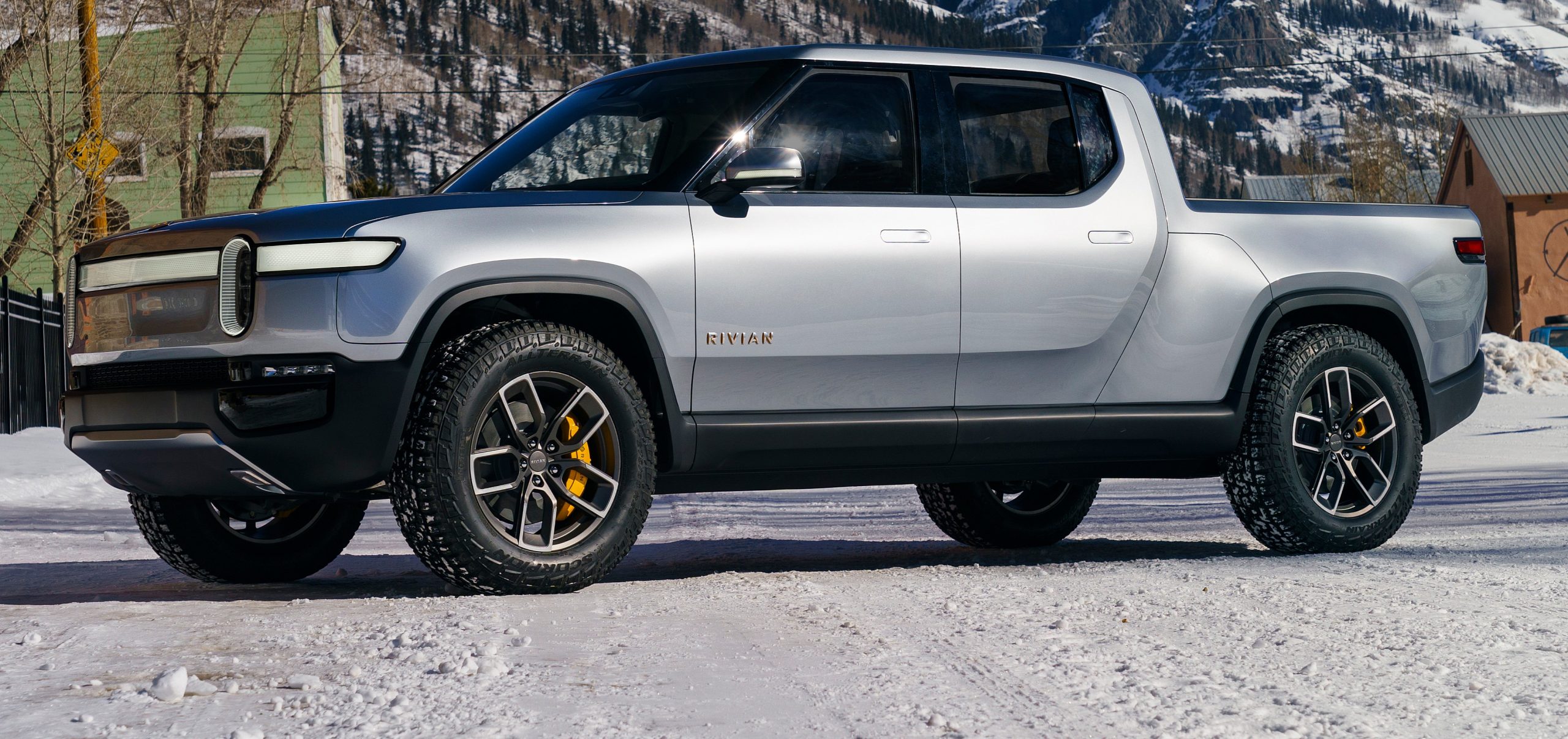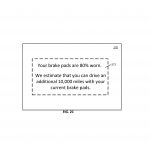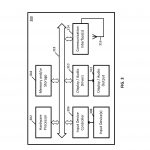

News
Rivian patent hints at real-time brake wear monitoring system using driver profiles
Rivian’s attention to detail on its all-electric vehicles is laudable, and a recent patent application by the outdoor adventure company for monitoring brake wear continues that theme. In an application titled “Methods, Systems, and Media for Non-Contact Brake Pad Wear Determination”, a method of estimating the wear on individual breaks via computer algorithms is described. Once calculated, the information is then made available to drivers for planning purposes via the infotainment screen on the R1T pickup truck and R1S SUV. The application published on August 1, 2019 under US Patent Publication No. 2019/0234475.
The background of Rivian’s application stated the following reasons why the invention is needed:
“Current approaches for determining brake pad wear…tend to merely indicate when brake pads are fully worn, for example, using a brake pad indicator that causes the brakes to squeal when the indicator contacts the brake disc or that causes an indication on a dashboard of the vehicle to be presented. It may be useful for a driver to know a current wear condition of the brake pads before the brake pads are fully worn, for example, to plan for vehicle maintenance. However, it can be difficult to determine a current wear of the brake pads.”
While not an official reason listed on the patent, one could also assume brake squealing as an annoying sound in itself would also merit the invention’s usefulness as a reliable preventative.
- Rivian brake-monitoring patent application. | Image: Rivian/USPTO
- Rivian brake-monitoring patent application. | Image: Rivian/USPTO
- Rivian brake-monitoring patent application. | Image: Rivian/USPTO
- Rivian brake-monitoring patent application. | Image: Rivian/USPTO
Overall, Rivian’s application calculates the amount of wear on its vehicles’ brakes by comparing data points gathered from two braking events. The amount of pressure applied plus the distance traveled at two different intervals is collected, then compared to a brake database, and an estimate of the mileage left before a change is needed is provided to the driver. The calculation can also include the driver’s braking history to more accurately reflect the mileage. In other words, if you’re a bit rough on the brake pedal, Rivian’s software will take that into account and probably shorten the mileage you have left before needing replacement parts compared to someone that drives…differently. Here’s the formal language for this ability:
“In some embodiments, the method further comprises associating a braking profile with an operator of the vehicle, wherein the indication of the wear amount of the brake pad includes a number of miles until the brake pad requires replacement that is estimated based on the associated braking profile.”
The method described in the claims of the application that calculate the wear on the brakes indicates a process initiated by the driver, i.e., the driver initiates a brake wear test on the center touchscreen and uses the brakes at two intervals as instructed by the vehicle’s computer to determine the wear percentage. However, the description of the application indicates that the brake testing can also happen in real-time during normal operation. The formal language for this reads as follows:
“…In some embodiments, [the testing] process…can receive a group of brake caliper measurements and corresponding brake pedal travel distances…during application of the brake pedal during normal operation of the vehicle…Additionally, in some such embodiments, [the testing] process can present indications of brake pad wear at any suitable time, such as a next time the vehicle is turned on, and/or at any other suitable time.”
This application is yet the latest nod towards Rivian’s development of a comfortable and luxury driving experience for its vehicle owners. The car maker’s branding as an outdoor electric adventure company really seems to have embraced its mission to get people outside exploring more by making the experience as convenient as possible. Whether it’s ample storage capacity, swapping out cargo modules, extending battery range with a digital jerry can, a portable kitchen built specifically for the R1T pickup truck, or now, being able to easily plan ahead for basic vehicle maintenance by checking a screen, Rivian is continuing its march against barriers to enjoying nature anywhere.
There’s a new phrase that seems to be developing based off of an old one about willpower: “Where there’s a Rivian, there’s a way.”

Elon Musk
Elon Musk and Tesla AI Director share insights after empty driver seat Robotaxi rides
The executives’ unoccupied tests hint at the rapid progress of Tesla’s unsupervised Robotaxi efforts.

Tesla CEO Elon Musk and AI Director Ashok Elluswamy celebrated Christmas Eve by sharing personal experiences with Robotaxi vehicles that had no safety monitor or occupant in the driver’s seat. Musk described the system’s “perfect driving” around Austin, while Elluswamy posted video from the back seat, calling it “an amazing experience.”
The executives’ unoccupied tests hint at the rapid progress of Tesla’s unsupervised Robotaxi efforts.
Elon and Ashok’s firsthand Robotaxi insights
Prior to Musk and the Tesla AI Director’s posts, sightings of unmanned Teslas navigating public roads were widely shared on social media. One such vehicle was spotted in Austin, Texas, which Elon Musk acknowleged by stating that “Testing is underway with no occupants in the car.”
Based on his Christmas Eve post, Musk seemed to have tested an unmanned Tesla himself. “A Tesla with no safety monitor in the car and me sitting in the passenger seat took me all around Austin on Sunday with perfect driving,” Musk wrote in his post.
Elluswamy responded with a 2-minute video showing himself in the rear of an unmanned Tesla. The video featured the vehicle’s empty front seats, as well as its smooth handling through real-world traffic. He captioned his video with the words, “It’s an amazing experience!”
Towards Unsupervised operations
During an xAI Hackathon earlier this month, Elon Musk mentioned that Tesla owed be removing Safety Monitors from its Robotaxis in Austin in just three weeks. “Unsupervised is pretty much solved at this point. So there will be Tesla Robotaxis operating in Austin with no one in them. Not even anyone in the passenger seat in about three weeks,” he said. Musk echoed similar estimates at the 2025 Annual Shareholder Meeting and the Q3 2025 earnings call.
Considering the insights that were posted Musk and Elluswamy, it does appear that Tesla is working hard towards operating its Robotaxis with no safety monitors. This is quite impressive considering that the service was launched just earlier this year.
Elon Musk
Starlink passes 9 million active customers just weeks after hitting 8 million
The milestone highlights the accelerating growth of Starlink, which has now been adding over 20,000 new users per day.

SpaceX’s Starlink satellite internet service has continued its rapid global expansion, surpassing 9 million active customers just weeks after crossing the 8 million mark.
The milestone highlights the accelerating growth of Starlink, which has now been adding over 20,000 new users per day.
9 million customers
In a post on X, SpaceX stated that Starlink now serves over 9 million active users across 155 countries, territories, and markets. The company reached 8 million customers in early November, meaning it added roughly 1 million subscribers in under seven weeks, or about 21,275 new users on average per day.
“Starlink is connecting more than 9M active customers with high-speed internet across 155 countries, territories, and many other markets,” Starlink wrote in a post on its official X account. SpaceX President Gwynne Shotwell also celebrated the milestone on X. “A huge thank you to all of our customers and congrats to the Starlink team for such an incredible product,” she wrote.
That growth rate reflects both rising demand for broadband in underserved regions and Starlink’s expanding satellite constellation, which now includes more than 9,000 low-Earth-orbit satellites designed to deliver high-speed, low-latency internet worldwide.
Starlink’s momentum
Starlink’s momentum has been building up. SpaceX reported 4.6 million Starlink customers in December 2024, followed by 7 million by August 2025, and 8 million customers in November. Independent data also suggests Starlink usage is rising sharply, with Cloudflare reporting that global web traffic from Starlink users more than doubled in 2025, as noted in an Insider report.
Starlink’s momentum is increasingly tied to SpaceX’s broader financial outlook. Elon Musk has said the satellite network is “by far” the company’s largest revenue driver, and reports suggest SpaceX may be positioning itself for an initial public offering as soon as next year, with valuations estimated as high as $1.5 trillion. Musk has also suggested in the past that Starlink could have its own IPO in the future.
News
NVIDIA Director of Robotics: Tesla FSD v14 is the first AI to pass the “Physical Turing Test”
After testing FSD v14, Fan stated that his experience with FSD felt magical at first, but it soon started to feel like a routine.

NVIDIA Director of Robotics Jim Fan has praised Tesla’s Full Self-Driving (Supervised) v14 as the first AI to pass what he described as a “Physical Turing Test.”
After testing FSD v14, Fan stated that his experience with FSD felt magical at first, but it soon started to feel like a routine. And just like smartphones today, removing it now would “actively hurt.”
Jim Fan’s hands-on FSD v14 impressions
Fan, a leading researcher in embodied AI who is currently solving Physical AI at NVIDIA and spearheading the company’s Project GR00T initiative, noted that he actually was late to the Tesla game. He was, however, one of the first to try out FSD v14.
“I was very late to own a Tesla but among the earliest to try out FSD v14. It’s perhaps the first time I experience an AI that passes the Physical Turing Test: after a long day at work, you press a button, lay back, and couldn’t tell if a neural net or a human drove you home,” Fan wrote in a post on X.
Fan added: “Despite knowing exactly how robot learning works, I still find it magical watching the steering wheel turn by itself. First it feels surreal, next it becomes routine. Then, like the smartphone, taking it away actively hurts. This is how humanity gets rewired and glued to god-like technologies.”
The Physical Turing Test
The original Turing Test was conceived by Alan Turing in 1950, and it was aimed at determining if a machine could exhibit behavior that is equivalent to or indistinguishable from a human. By focusing on text-based conversations, the original Turing Test set a high bar for natural language processing and machine learning.
This test has been passed by today’s large language models. However, the capability to converse in a humanlike manner is a completely different challenge from performing real-world problem-solving or physical interactions. Thus, Fan introduced the Physical Turing Test, which challenges AI systems to demonstrate intelligence through physical actions.
Based on Fan’s comments, Tesla has demonstrated these intelligent physical actions with FSD v14. Elon Musk agreed with the NVIDIA executive, stating in a post on X that with FSD v14, “you can sense the sentience maturing.” Musk also praised Tesla AI, calling it the best “real-world AI” today.












